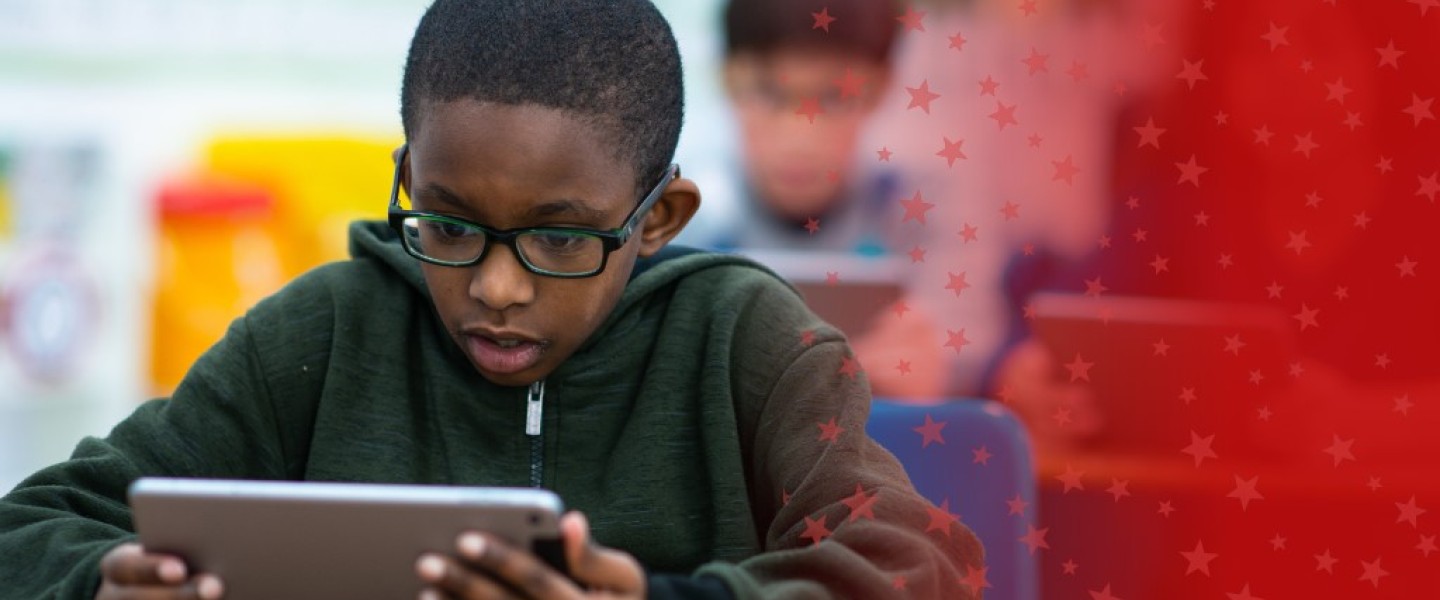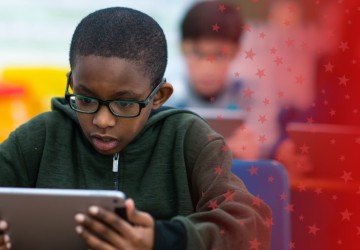Modern elementary school students have grown up alongside technology, often discovering how to navigate the latest devices in infancy and throughout early childhood. As a result, they are very comfortable with digital devices and tools—but that doesn't mean that digital learning in elementary school should entirely replace traditional teaching methods.
Rather than trying to replace materials with digital devices, educators can rely on these tools to complement their lessons. This can make the learning environment more fun and engaging for these young students.
Significance of Technology in Elementary Education
It wasn't that long ago that digital devices played a minor role in the school experience. Students may have had the opportunity to work on community classroom computers once or twice per week, or they may have visited the computer lab several times during the year to be exposed to new technology.
Today, however, technology in elementary school is an essential part of the learning experience. According to the National Center for Educational Statistics, 45% of public schools in 2021 offered one-to-one technology programs where each student had access to a device, and an additional 37% of public schools provided students with individual access to devices in certain grade levels. As educators strive to prepare students for an interconnected, digital world, digital tools is becoming more prevalent in classrooms with each passing year.
Role of Technology in Modern Classrooms
Explorance reports that digital tools play a crucial role in modern classrooms. They can be used to:
- Allow students to develop digital literacy skills and proficiency with the most advanced technology.
- Improve access to a wide range of resources.
- Differentiate the learning experience to cater to the individual needs of students.
Advantages of Integrating Technology in Elementary Education
Within the elementary classroom environment, technology can be incredibly beneficial. Some of the advantages of integrating these tools into elementary classrooms include:
- Helping students strengthen their technology and digital literacy skills.
- Providing students with fun ways to engage in new topics and concepts.
- Monitoring and tracking student progress in a more transparent way.
- Documenting activities and events that happen in the classroom to build a stronger parent-classroom community.
Distinct Ways to Incorporate Technology in Learning
Elementary educators can take a thoughtful and innovative approach to digital tools in the classroom. These are just a few ways modern educators can use these tools effectively in the elementary learning environment:
Digital Interactive Activities for Active Learning
One of the most common misconceptions about technology in the classroom is that it focuses solely on screen time and prevents children from completing hands-on activities. However, many of the latest educational technology tools provide students with interactive and engaging experiences that teach them how to collaborate in a digital world. For example, Nearpod states elementary teachers can provide students with a digital whiteboard and ask them to draw an illustration based on the story they just heard. The students may enjoy using these interactive devices and can strengthen their fine motor skills while simultaneously learning how to manipulate the device.
Use of Multimedia for Diverse Subjects
When exploring a new topic that may not be as familiar or even as accessible as other topics, teachers can rely on multimedia to provide students with relevant and engaging information. For instance, if a teacher is giving a social studies lesson about a country in Asia, they can pull up videos on YouTube showcasing what festivals are like in that country and what a typical day in school may be like. Then, they can listen to a song from that country on a music streaming app. There are numerous ways to use technology to provide students with an authentic and immersive learning experience that increases their global understanding and cultural awareness.
Virtual Reality as a Learning Tool
Virtual reality has rapidly evolved into one of the most relevant and immersive experiences of our time. With this being said, educators have discovered it can be a powerful learning tool.
Many students enjoy using VR to play games during their personal time, so incorporating it into the classroom makes the learning environment fun and exciting. Teachers can use this technology to break down boundaries of the classroom and explore new worlds in the digital sphere. Many teachers are beginning to incorporate VR field trips into their classrooms, giving students an opportunity to virtually visit museums, experience thrilling adventures in natural environments or discover more about a culture from a far-away land.
Benefits of Digital Tools in Classroom
Modern learners are so comfortable with digital tools, they often prefer to work with these devices rather than traditional tools like paper, pencils, and crayons. Digital devices can keep them engaged and interested in the topic and inspire them to think creatively.
Enhancing Student Engagement and Creativity
Modern learners are so comfortable with technology, they often prefer to work with these devices rather than traditional tools like paper, pencils, and crayons. These digital tools can keep them engaged and interested in the topic and inspire them to think creatively.
Promoting Collaboration and Inclusion
Most of today's cloud-based, educational learning tools provide students with innovative ways to collaborate with one another. For instance, in classrooms across the country, students complete assignments on Google Drive and can seek feedback and collaborate with classmates in real-time on their devices.
Assisting in Differentiated Learning
By integrating various devices and technological tools into the classroom environment, teachers can differentiate the learning experience to cater to the individual needs of each student. For example, teachers who use reading apps in their classroom can adjust student access to books and materials by inputting their reading levels, ensuring every student is focused on material that best meets their needs at that time.
Educational Apps to Boost Teaching and Learning
These are some up-and-coming educational apps that have been shown to enhance the learning environment at the elementary level:
FlipGrid for Video-Based Discussions
FlipGrid is an easy-to-use, video-sharing app that has become popular in elementary classrooms around the country. Citing Edutopia, FlipGrid allows students to share and post video responses to a particular topic. Most recently, this app has been using augmented reality to enhance the digital learning experience for all students.
Zoom for Virtual Learning
During the global pandemic, Zoom became the most critical piece of educational technology. This video-conferencing software helped teachers and students engage in real-time virtual learning and it continues to play a pivotal role in remote instruction today.
Nearpod for Interactive Lessons
A student engagement platform, Nearpod makes it possible for teachers to quickly design interactive lessons. Per Nearpod, some of the best ways to use this tool in the classroom include creating polls for live assessment, modeling work for students and exploring gamification.
Preparing Future Educators for Tech-Enabled Teaching
The bottom line is that digital tools will continue to play a prominent role in the classroom environment, so educators must acclimate to the world of tech-enabled learning.
Teaching Degrees Emphasizing Importance of Technology
Choosing a teaching degree program that emphasizes the importance of classroom technology will allow you to become a future-forward educator who values new and developing technology, and can also clarify which certification route best aligns with your long-term goals in the classroom.
Developing a Growth Mindset for Tech Adoption
Practicing with the latest digital tools and resources will help you become more comfortable and receptive to advancing technology. Rapid changes in digital tools can make it seem intimidating, but teachers must be willing to grow and adapt to them, especially if you're exploring a structured pathway into middle school teaching.
Real-World Examples of Technology Use in Classrooms
Teachers are often inspired by other educators using digital tools in innovative and exciting ways. Here are a few real-world examples of technology in elementary schools to consider:
Digital Field Trips for Experiential Learning
Traditional field trips can be a logistical nightmare for teachers, leaving them with coordinating transportation, securing chaperones and navigating costs associated with these trips. However, digital field trips can be just as valuable and immersive and they are far more accessible. Many museums and attractions around the country offer virtual field trip experience, and VR technology is making these experiences even more inviting.
Gamified Learning for Enhanced Student Participation
There's no doubt elementary students love gaming, which is why gamified learning has become so favored at this level. This form of social learning helps students engage in peer-to-peer competition, collaborative learning and multiplayer challenges. In addition to providing students with an interactive way to explore the topic, gamification also promotes the development of critical-thinking and problem-solving skills while building a stronger community environment in the classroom.
How Can Tech Integration Prepare Students for the Future?
Giving students access to the latest digital devices and tools in a classroom environment allows them to safely explore these devices and develop critical digital skills they need for the future. As digital tools advance and continually reshape and redefine what daily life looks like both within and outside the classroom, students must begin developing their foundation of transferable, digital skills today.
Explore How Technology Complements Education at University of the Cumberlands
At University of the Cumberlands, our Bachelor of Arts in Elementary Education is designed to provide students with a future-forward look at the educational landscape. You’ll learn the best practices in education and explore the most reliable teaching strategies while mastering how to effortlessly weave technology into the educational experience for elementary learners.
Request more information about our education bachelor's degree programs today.

